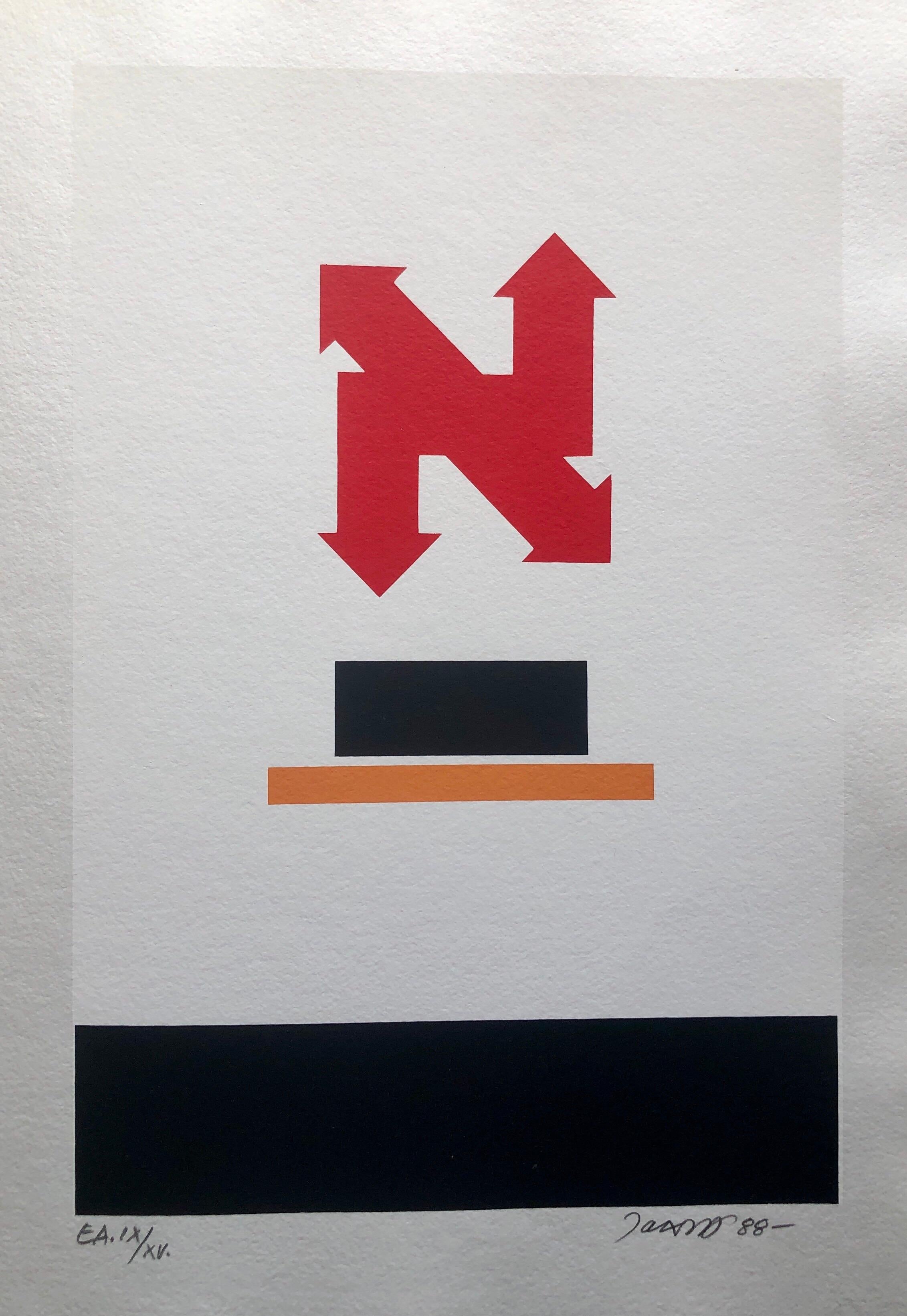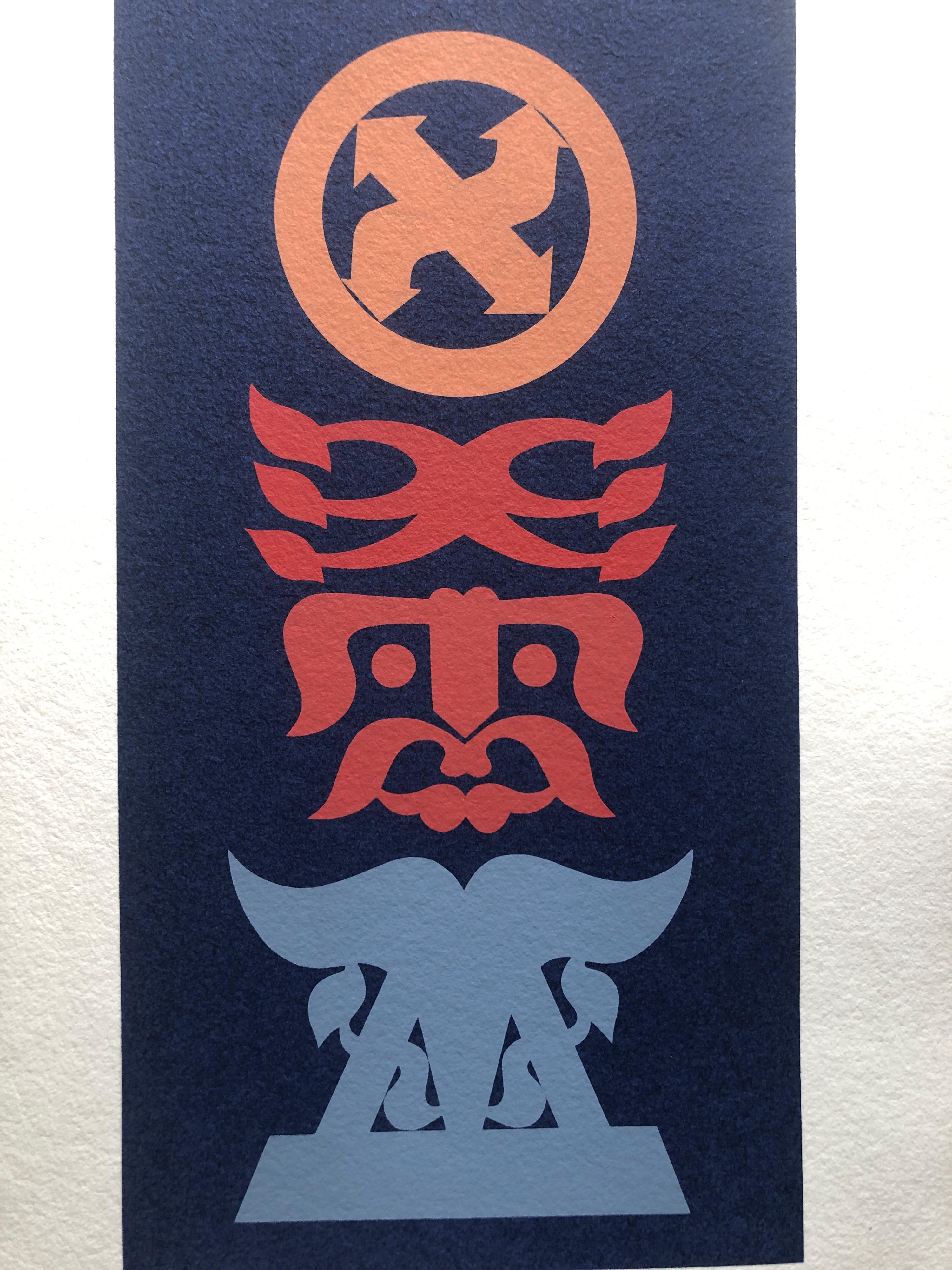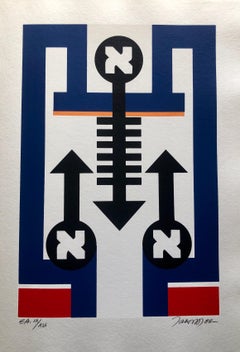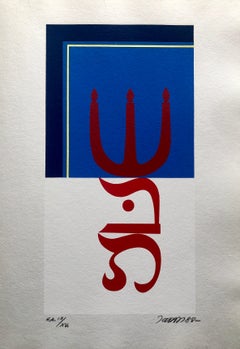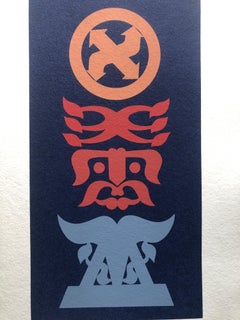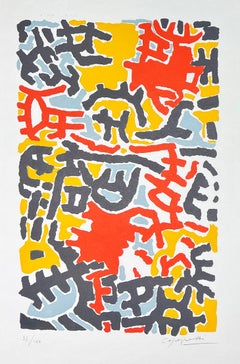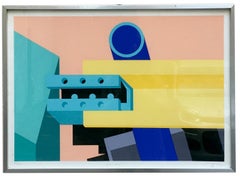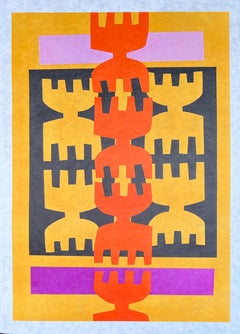Items Similar to Hungarian Surrealism Pop Art Hebrew Silkscreen Judaica Print Jewish Serigraph
Want more images or videos?
Request additional images or videos from the seller
1 of 10
Jozsef JakovitsHungarian Surrealism Pop Art Hebrew Silkscreen Judaica Print Jewish Serigraph1988
1988
$600
£455.71
€526.50
CA$840.92
A$941.15
CHF 491.21
MX$11,477.17
NOK 6,286.79
SEK 5,951.25
DKK 3,929.21
Shipping
Retrieving quote...The 1stDibs Promise:
Authenticity Guarantee,
Money-Back Guarantee,
24-Hour Cancellation
About the Item
Abstract Hebrew Prints on heavy mould made paper from small edition of 15. there is a facing page of text in Hungarian folded over. Hard edged geometric abstract prints in color based on the Hebrew alphabet done in a calligraphy typeface.
Jozsef Jakovits, Hungarian (1909 - 1994) painter, graphic artist, sculptor. Representative of modern art trends of the 20th century . Member of the Széchenyi Academy of Literature and Art (1993).
József Jakovits was the leading sculptor among Hungary's Modernist art group, the European School, whose brilliant program of exhibitions, lectures, and publications lasted from 1945 until 1948, when Communist cultural czars crushed it.
He worked for the Hungarian Royal State Iron, Steel and Machine Works between 1935 and 1944. In 1945, he met the widow of Lajos Vajda, Júlia Vajda , a painter with whom he married, so he joined the European School , where he was engaged in sculpture and in 1948 at the European School XXXVI. On the occasion of his exhibition, he issued with Júlia Vajda. In 1948, his studio was taken away because of nationalization, at that time he destroyed many of his statues, and could not work until 1950. From 1950 he worked as a colleague of the State Theater of Bán (1950-55) and then of Kisfaludy Theater in Győr (1955-58). In 1951 he received a small room from the Puppet Theater, where he made sculptures again. Meanwhile, he became a member of the Fine Arts Foundation. From 1961 to 1965 he made his only public artwork from the artificial stone to Napora , which was set up in the garden of the Korányi TBC Medical Center in Budapest in 1965. (He made plans for four more public sculptures, but they were not implemented, so they were destroyed by the author). He lived in New York until 1965-1987, and began painting there. His painting themes are inspired by the mysticism of Kabbalah and calligraphy of Hebrew writing. He both met in New York, his paintings remained in America, but he took his calligraphic and mysticism approach into sculptures. In 1985 he received US citizenship, but in 1987 he was repatriated and lived in Budapest until his death.
According to his own testimonies, painters influenced him ( Lajos Vajda , Max Ernst , Joan Miro , Pablo Picasso ), but above all the art of the prehistoric and natural peoples, the classical European culture felt a challenge, but also coped with its effects and incorporated it into his art.
Some of his first work was also made completely abstract compositions of wire and statues of the spirit of organic life, growth, breakout, and his works in the spirit of Hans Arp works. The first period of his art (1945-48) was extremely productive, nearly one third of his statues were made at that time. His works also included playfulness and lightness ( Hármas fókák , 1946, Dolphins , 1947), but the tragic bitterness ( Child Murder , 1947) and grotesque hardness ( Hitler , 1946). His statues are characterized by a varied spatial play of asymmetry and forms.
His career also included painting and drawings and the Revolutionary Series IX stands out. (1956), He also made photo collage montages, including Montage on a blue background IX, linoleum sections, screen prints. Six of the latter were published in an album, 70 numbered copies by the Corvina Publishing House in 1988. Inspired by Surrealism and Primitivism. His sculpture resonated with primal sexuality and spirituality, blending genders, animal and human characteristics, and sacred and secular themes. This stance was inherently political in conservative and communist Hungary, and Jakovits's overtly anti-totalitarian work was even more intolerable in Hungary. Grasping an opportunity to emigrate to the United States in 1965, Jakovits settled in New York City in 1965. He quoted Richard Huelsenbeck’s The Dada Drummer: “The artist must by necessity stand outside the social group.” Tidy and efficient, he lived ascetically, in poverty, in a 430-square-foot apartment in a public-housing complex on Water Street. To meet his modest needs of $175 per month—including his art supplies from Pearl Paint—he performed work provided by welfare three days every second week. He said a broad-hipped Jewish woman who worked for the city secured his survival package, which included being registered as a mentally challenged person eligible for aid. This surrogate status also inhibited him from seeking exhibitions and publicity. Despite his monasticism he had television—he watched, from the outside looking in. While America experienced its volatile 1960s, as 1968 came and went, Jakovits was absorbed in painting, having switched his main medium from sculpture. The chance encounter with the Hebrew primer in 1966 was a revelation to Jakovits. He turned from Surrealism to mysticism. He dedicated himself to absorbing and celebrating the esoteric knowledge of Kabala. For more than two decades, he rendered Hebrew letters and kabbalistic motifs, employing the flat colors, hard edges, and stenciled designs of Pop Art but in service of the sacred rather than the popular.
Jakovits is "little-known today even in his native Hungary, except in intellectual and artistic circles, where he is hailed as Hungary's foremost Surrealist sculptor. In the Hungarian National Gallery he is labeled 'post-Surrealist.' Jakovits viewed himself as a Primitivist, declaring his main sources to be 'cave painting, the tribal art of primitive peoples, and the archaic periods of the great religious cultures'--including Judaic lettering and mysticism."
There was an excellent book written about him by art historian Gary van Wyk titled József Jakovitz: Surrealist, Primitivist, Kabalist. some of this biographical material is drawn from the book.
Individual exhibitions:
1948 sculptures and pictures of Júlia Vajda, European School XXXVI, Üllői út 11-13, Budapest
1973 Júlia Vajda, Exhibition of Renée Kelemen, Chapel of Balatonboglár • New York, New York, Exhibition of his paintings, House of Living Judaism, New York
1980 • Exhibition Lajos Hatvany Museum, Hatvan
1983 • exhibition of sculptor, Hungarian National Gallery, Budapest
1988 • Meeting with the artist, Hungarian National Gallery, Budapest
1989 • Graphic Exhibition of Sculptor, Gallery Erzsébetvárosi, Budapest
1989 • I am who I am, Gallery Fészek, Budapest
1993 • Revolutionary series 1947-1956-1957, ~ Academy Exhibition, Balassi Bookstore, Budapest
1995 • Ildikó Bálint, ~ and Endre Lukoviczky, Workshop Gallery, Szentendre
1996 • Memorial Exhibition, Ernst Museum, Budapest (cat.)
1998 • Montage, Vintage Gallery, Budapest
2002 • Jewish Museum - New York Paintings
2009 • JAKI 100. József Jakovits was born a hundred years ago, 2B Gallery, Budapest.
Selected group exhibitions
1946 • The Hungarian Art Exhibition of Abstract Art, Free Organization of Fine Arts, Budapest • Hungarian Fine Arts Movement Exhibition I, Ernst Museum, Budapest
1947 • New Worldview, Exhibition of the Gallery to the Four Worlds, Bookstore of Mistótfalusi • National Exhibition, Budapest Gallery, Budapest • Abstract Art II.
1948 • 1948. New trends in Hungarian art, National Salon, Budapest • European School XXXIII. "We ourselves", Üllői út 11-13., Budapest • Exhibition of 90 artists, National Salon, Budapest
1949 • Hungarian Homes, Metropolitan Gallery, Budapest
1956 • Exhibition of 7 artists, Christian Museum, Esztergom
1957 • Spring Exhibition, Art Gallery, Budapest
1962 • Modern Architecture - Modern Fine Arts, Builders Club, Budapest
1966 • 125 Years of Hungarian Photography, Hungarian National Gallery, Budapest
1969 • Szentendre Art, Csók Gallery, Székesfehérvár
1972 • Hungarian Art, Indiana University Art Museum, Bloomington
1973 • European School. Hungarian art of the twentieth century, Csók Gallery, Székesfehérvár
1975 • Today's Hungarian Artists, Hungarian National Gallery, Budapest
1976 • Dreams, Myths and Imaginary Landscapes, ML Gallery of Fine Arts, New York • Exposure. Photo / art, Lajos Hatvany Museum, Hatvan
1977 • Pictures and sculptures from 30 years of Hungarian art, Budapest History Museum, Budapest • Hungarian Art 1945-49. Hungarian art of the twentieth century, Csók Gallery, Székesfehérvár
1981 • Hungarian Art 1920-1970, Northeastern University Art Gallery, Boston • The fifties. Hungarian art of the twentieth century, Csók Gallery, Székesfehérvár
1982 • The collage in Hungarian art, 1920-1965, Kassák Memorial Museum, Budapest • Memorial of Ernő Kállai, Óbuda Gallery, Budapest • Respect the homeland. Hungarian artists living in Hungary II. Exhibition, Art Gallery, Budapest
1983 • Rottenbiller Street 1, Revolutionary Museum, Szombathely
1984 • The (unknown) European School, Budapest Gallery, Budapest
1987 • The "old" avant-garde. Exhibition of 8 artists from Szentendre, Workshop Gallery, Szentendre
1988 • Formal forms II., Gallery Fészek, Budapest
1989 • Other, Ernst Museum, Budapest
1990 • VIII. International Small Sculpture Triennial, Art Gallery, Budapest
1991 • Sixties. New aspirations in Hungarian art, Hungarian National Gallery, Budapest
1992 • Montage, St. Stephen's King Museum, Székesfehérvár
1994 • Kisszobor '94, Vigadó Gallery, Budapest
1995 • New Works, Metropolitan Gallery, Budapest
1996 • My Museum. Selection from the Vass Collection, Ernst Museum, Budapest
1999 • Selection from the Levendel Collection, Metropolitan Gallery, Budapest.
Works in public collections
Metropolitan Gallery, Budapest
Janus Pannonius Museum, Pécs
Kassák Memorial Museum, Budapest
Hungarian National Gallery, Budapest
Szombathely Gallery, Szombathely.
- Creator:Jozsef Jakovits (1909 - 1994)
- Creation Year:1988
- Dimensions:Height: 15 in (38.1 cm)Width: 10.5 in (26.67 cm)
- Medium:
- Movement & Style:
- Period:
- Condition:good. never framed.
- Gallery Location:Surfside, FL
- Reference Number:1stDibs: LU38214152502
About the Seller
4.9
Platinum Seller
Premium sellers with a 4.7+ rating and 24-hour response times
Established in 1995
1stDibs seller since 2014
1,782 sales on 1stDibs
Typical response time: <1 hour
- ShippingRetrieving quote...Shipping from: Surfside, FL
- Return Policy
Authenticity Guarantee
In the unlikely event there’s an issue with an item’s authenticity, contact us within 1 year for a full refund. DetailsMoney-Back Guarantee
If your item is not as described, is damaged in transit, or does not arrive, contact us within 7 days for a full refund. Details24-Hour Cancellation
You have a 24-hour grace period in which to reconsider your purchase, with no questions asked.Vetted Professional Sellers
Our world-class sellers must adhere to strict standards for service and quality, maintaining the integrity of our listings.Price-Match Guarantee
If you find that a seller listed the same item for a lower price elsewhere, we’ll match it.Trusted Global Delivery
Our best-in-class carrier network provides specialized shipping options worldwide, including custom delivery.More From This Seller
View AllHungarian Surrealism Pop Art Hebrew Silkscreen Judaica Print Jewish Serigraph
By Jozsef Jakovits
Located in Surfside, FL
Abstract Hebrew Prints on heavy mould made paper from small edition of 15. there is a facing page of text in Hungarian folded over. Hard edged geometric abstract prints in color base...
Category
1980s Abstract Geometric Abstract Prints
Materials
Archival Paper, Screen
Surrealist Abstract Hebrew Aleph Pop Art Silkscreen Judaica Jewish Serigraph
By Jozsef Jakovits
Located in Surfside, FL
Abstract Hebrew Prints on heavy mould made paper from small edition of 15. there is a facing page of text in Hungarian folded over. Hard edged geometric abstract prints in color base...
Category
1980s Pop Art Abstract Prints
Materials
Archival Paper, Screen
Surrealist Abstract Hebrew Shabbat Pop Art Silkscreen Judaica Jewish Serigraph
By Jozsef Jakovits
Located in Surfside, FL
Abstract Hebrew Prints on heavy mould made paper from small edition of 15. there is a facing page of text in Hungarian folded over. Hard edged geometric abstract prints in color base...
Category
1980s Pop Art Abstract Prints
Materials
Archival Paper, Screen
Hungarian Surrealist Abstract Hebrew Silkscreen Judaica Print Jewish Serigraph
By Jozsef Jakovits
Located in Surfside, FL
Abstract Hebrew Prints on heavy mould made paper from small edition of 15. there is a facing page of text in Hungarian folded over. Hard edged geometric abstract prints in color base...
Category
1980s Abstract Geometric Abstract Prints
Materials
Archival Paper, Screen
Israeli Surrealist Judaica Abstract Lithograph Naftali Bezem
By Naftali Bezem
Located in Surfside, FL
Naftali Bezem (Hebrew: נפתלי בזם; born November 27, 1924) is an Israeli painter, muralist, and sculptor.
Bezem was born in Essen, Germany, in 1924. His early adolescence was spent...
Category
20th Century Modern Prints and Multiples
Materials
Lithograph
Rare Israeli Surrealist Judaica Abstract Lithograph Naftali Bezem
By Naftali Bezem
Located in Surfside, FL
Fine lithograph on deckle edged French Arches paper. Pencil signed and numbered from edition of 150.
A Surrealist Judaica scene of a bearded man (Rabbi) in a boat with Shabbat candlesticks. with blindstamp from Editions Empreinte in Paris, France. (They published, Jean Michel Folon, Sempe, Raoul Ubac, Raymond Savignac, Cesar, Bengt Lindstrom , Paul Aizpiri and many other modern masters.
Naftali Bezem (Hebrew: נפתלי בזם; born November 27, 1924) is an Israeli painter, muralist, and sculptor.
Bezem was born in Essen, Germany, in 1924. His early adolescence was spent under Nazi oppression, in constant fear for the safety of his parents, who perished in the Holocaust in the Polish Auschwitz concentration camp. Naftali emigrated to Mandate Palestine in 1939, at the age of fourteen with a Youth Aliyah group.
From 1943 to 1946, he studied art at the Bezalel Academy of Art and Design in Jerusalem with Israeli painter Mordecai Ardon. He then spent three years studying in Paris.His most famous public works include a wall relief at Yad Vashem in Jerusalem and the ceiling mural in the main reception room at the President's Residence, Jerusalem.In 1957, Bezem was a co-recipient of the Dizengoff Prize for Painting.
Group Exhibitions
Orit Art Gallery, Tel Aviv
Artists: Yosef Zaritsky, Marcel Janco, Lea Nikel, Robert Baser, Bezem, Michael Druks,
Israeli Painting (Watercolors and Gouache)
Artists:
Pinchas Abramovich, Bezem, Naftali Nachum Gutman, Haim Gliksberg, Mordechai Levanon, Avigdor Stematsky, Avshalom Okashi, Yehiel Krize...
Category
20th Century Modern Figurative Prints
Materials
Lithograph
You May Also Like
Giuseppe Capogrossi (1900-1972) - Coloured lithograph on paper - 1952
By Giuseppe Capogrossi
Located in Varese, IT
Lithographie.
Coloured lithograph on paper, edited in 1952.
Limited edition of 120 copies, numbered as 33/120 in lower left corner.
Hand-signed by artist in pencil in the lower righ...
Category
1950s Pop Art Abstract Prints
Materials
Paper, Lithograph
WITHOUT TITLE- Color silkscreen print signed Delphos , Italy 1970s
Located in Napoli, IT
Abstract composition - Lithograph signed Deplhos and numbered 62/100, bright colors Memphis style
Category
1970s Modern Abstract Prints
Materials
Paper, Screen
Giuseppe Capogrossi (1900-1972) - Lithograph on Japanese paper - 1970
By Giuseppe Capogrossi
Located in Varese, IT
Quarzo N° 4
Rare deluxe issue lithograph printed on extremely fine Japanese paper, edited in 1970.
Limited edition of 15 copies on Japanese paper and some artist's proofs, numbered ...
Category
1970s Pop Art Abstract Prints
Materials
Paper
Untitled ( 1/20 A.P.)
By Moshe Givati
Located in New York, NY
Moshe Givati (Israeli 1934-2012), "Untitled" Edition 1/20 Artist Proof, Abstract Serigraph Screen Print, 39 x 27, Mid 20th Century
Colors: Brown, Yellow, Blue, Orange, Red, Pink, Gr...
Category
Mid-20th Century Abstract Abstract Prints
Materials
Screen
1970 Signed Limited Edition Large Screen Print II
By Jimmy Ernst
Located in Rochester Hills, MI
Jimmy Ernst
Plate II - 1970
Print - Screen Print on Heavy Paper 28'' x 37'' inches
Edition: Signed in pencil and numbered 24/125
Jimmy Ernst’s artwork was influenced by a number of powerful talents and vital currents in the art of his time. Son of Max Ernst, Jimmy drew upon the biomorphic and surreal compositions of his father, as well as Arp, Klee, André Breton, and Lyonel Feininger. His mature oil paintings, which emerged in the 1950s and 1960s, reflect the Atomic Age aesthetic of the period. Often, they resemble crystals or webs; many look like vast labyrinths and are interpreted as symbols of the unconscious mind.
Ernst was always interested in spirituality and drew inspiration from indigenous American art...
Category
1970s Abstract Abstract Prints
Materials
Screen
$640 Sale Price
20% Off
1970 Signed Limited Edition Large Screen Print III
By Jimmy Ernst
Located in Rochester Hills, MI
Artist: Jimmy Ernst
Title: Plate III
Year: 1970
Print: Screen Print on Heavy Paper 28'' x 37'' inches
Edition: Signed in pencil and numbered 1 /125
Jimmy Ernst’s artwork was inf...
Category
1970s Abstract Abstract Prints
Materials
Screen

